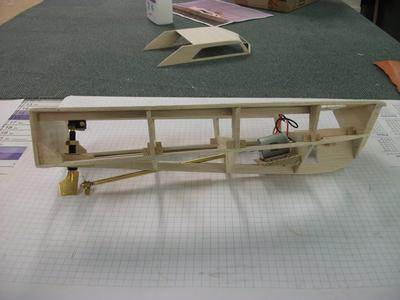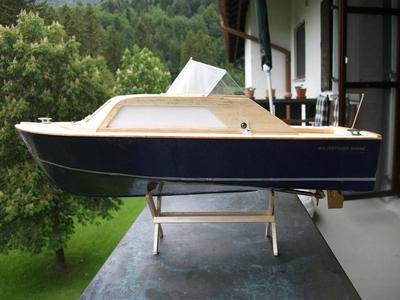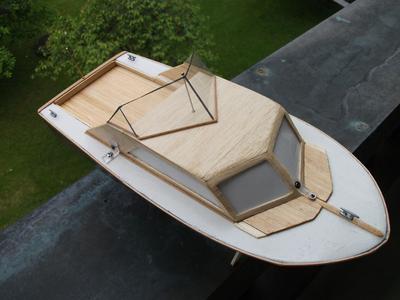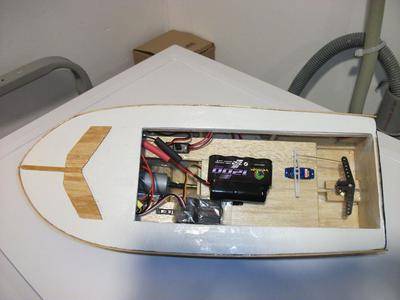RC Cabin Cruiser from scratch "Bon Vivant" - First wooden project
by Bruno
(Garmisch-Partenkirchen, Germany)




For starters this is the very first thing I ever made out of wood. So you will see my version of Petter’s small cruiser is not a perfect boat. However, I’m very happy and even proud with the result for being a first try. How I got here? I wanted to get a nice R/C boat in the form or shape of either a 70s Sport Fisherman or a 70s Cabin Cruiser. Unfortunately, there is nothing like that out there. All I came across are the “classic” boats, the racing boats, 50s or early 60s sports fishermen, sailboats, military or commercial vessels or just plastic toy boats. So fortunate enough, I came across Petter’s Small Cruiser plan for dummies (I mean, starters) like me. I immediately noticed a potential to make it somewhat resemble one of my favorite boats, an early 70s 25-footer Chris Craft Catalina. As I went along with my work (it took me a little bit over 3 months due to my inexperience and countless unrelated distractions) I ended up with a
boat full of modifications, but with almost an identical hull.
As for its technical changes I’ using a 7.4v battery pack. I kept the same speed controller suggested by Petter and a different motor since I smoked the Cermag unit during initial trials due to the higher voltage. Fun while it lasted. I also got a commercially available brass drive shaft, a rudder and a propeller (3 blade 25mm M2 propeller; an 8” mini drive shaft). I had to cut the shaft a little bit, so next time I will order a shorter one. As a link between drive shaft and motor, I got a little rubber link from the same supplier since where I live some simple things like a tiny silicone tube can be difficult to find.
As for the current motor (just around $8.50 with shipping and handling) which I got through Ebay, these are the specifications:
Mabuchi Series: RC-280SA-2485
Overall Length: 45mm Including Shaft
Voltage Range: 4.5VDC - 9VDC
6VDC is Nominal
No load @ 6VDC::
Speed: 10,800 RPM
Current: 180mA
Medium load (Max Efficiency) @ 6VDC:
Speed: 8,800 RPM
Current: 600mA
Torque: 33g-cm
Stall @ 12VDC:
Torque: 185g-cm
Current: 2.5A
Size Specs:
Overall (Including Shaft): 45mm long x 24mm diameter
Canister: 30.5mm Long (34mm with bushings) x 24mm diameter
Shaft (Smooth, Round): 11mm x 2mm diameter
Operates in either Direction (switch polarity)
3 Pole Armature
85 Turns of 0.25mm wire per turn
Mounting Holes are NOT threaded
2 Solder Tabs for Connection
Weight: 44g (1.6oz)
Great thing was that I used the same nice Cermag motor mount for the new Mabuchi motor. As running time, you may run non-stop full speed ahead for about 10 min and the battery will still have power to go on. The problem is that at that pace you will fry the motor due to overheating. I know this because I kill one (yes, another motor!) like this. So I’m assuming you will have around 15-20 minutes, perhaps 25 minutes of fun if you treat your motor in a civilized manner. Other significant materials I used included marine lacquer, normal off-the-shelf spray car paint and Elmer’s-like waterproof wood glue. Knowing I would waste lots of wood due to my newbie status, I ordered double of what Petter recommended. I’m very glad I did.
Now the boat. The plans worked great. As a beginner, sanding was a challenge due to the patience required, but it paid off. Mine was far from perfect, but as the work kept going and I saw it turning into something beyond my expectations I became a little bit more demanding. Since I’m not too patient, I admit I skip some recommendations. Something I altered a bit was the rear transom. It was too square-shaped for my taste, so I altered it as a with a very slight semi-v shape and rounded the edges a little bit for a more realistic appearance. Once I built the frame, I applied a first coat of marine lacquer. My biggest challenge: planking. Since there are no planking templates with the plan, I had to make my own. Once planked, I coated the entire hall with marine lacquer more than twice. Perhaps it was too much, but I wanted to avoid any risk of leaks. In fact, I did varnished the bow planks before installing since later it would have been
impossible to reach them from the inside. And then to the cabin. The plans called for a cardboard cabin, but after going this far I went wood. Since I did not knew how to attach the cabin to the hull in a decent way, I ended up improvising by adding 3 tiny screws and small pieces of plastic to keep it firmly in place and be able to open it at will while keeping it fairly covered from the elements.
After all that work, the boat came up the way you see it. I ruined the paint job a couple of times, but after putting a couple of coats of car paint lacquer, it ended up looking somehow like fiberglass, which concealed most of the gaps I left during paneling. I only wish I could find little accessories like chairs, steering wheel, etc, to make it look nicer. I see myself improvising some in the future.
It navigates very well. Petter did a terrific job with this design. Very stable and pretty rugged. What would I change? I would make it a little bigger to accommodate a bigger engine (yeah yeah!), perhaps 3 more inches or so. I would also change the bow design to make it a little bit more modern (just my taste). One I think would look great is the one in the old 1970s Bertrams, especially the 46.6 Convertible (aka sports fisherman) or the 1970s Chris Craft Commanders. However, the current shape is pretty functional and capable when heading little waves with my engine arrangement.
Petter, here is a suggestion: Take this great platform, make it a little bit larger (perhaps up to 20 inches) design a sports fisherman with it like the 70s Bertram, Chris Craft or Hatteras, and I assure you many people will request you plans right away. I’ll be the first one in line.
Thank you for bringing realistic hope to R/C modeling super-green newbies like me!













